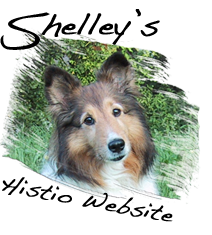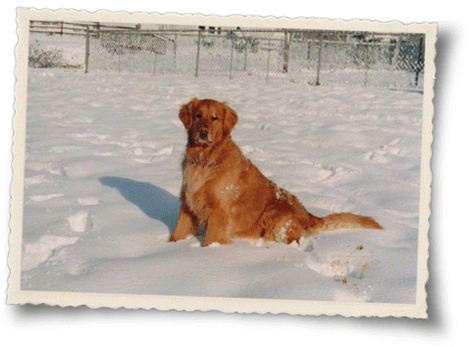
HOME
 YOUR HISTIO STORY
YOUR HISTIO STORY
I am looking for similarities
in all individual cases of
Histiocytic diseases.
I wonder if we all tell our
stories we might come up
with some commonality
between the specific
situations in which all of
our pets got this disease.
So please email me the
details and I'll put your
pets story on Shelley's
Histio Website
 UW HISTIO VERHAAL
UW HISTIO VERHAAL
Ik ben op zoek naar
overeenkomsten in alle
individuele gevallen van
Histiocytose.
Ik hoop dat wanneer wij
onze Histio verhalen
vertellen, wij overeen-
komsten ontdekken over
de manier waarop onze
huisdieren deze ziekte
hebben opgelopen.
Stuur mij de details en
ik zal het verhaal van uw
huisdier op de Histio
website van Shelley zetten.
 WARNING !
WARNING !
These stories are all
different. Individual
symptoms, situations
and circumstances
may vary and response to
therapy is not always the
same.
- Disclaimer -
 WAARSCHUWING !
WAARSCHUWING !
Deze verhalen zijn allemaal
verschillend. Individuele
symptomen, situaties en
omstandigheden kunnen
verschillen en de reactie
op therapie is niet altijd
hetzelfde.
- Disclaimer -
HISTIOCYTOSIS IN
OTHER LANGUAGES
German - Hund
Maligner Histiozytose
French - Chien
l'Histiocytose Maligne
Italian - Canis
Maligni Histiocytosis
Spanish - Perros
Histiocitosis Maligna
Dutch - Hond
Maligne Histiocytose
HOME
Murphy
Malignant Histiocytosis
Golden Retriever
Male
July 5, 1996 - February 8, 2006


Story told by Jim Saxon
Murphy, a Golden Retriever, had a full life of competing in Hunting Tests, Tracking Tests, mentoring foster dogs, socializing with friends, and doing therapy dog work. Most of all he was a great buddy to me. However, I am most proud of him for how he handled the last 4 months of his life.
In May or June of 2005 I began noticing an occasional, slight limp after exercise which only lasted a minute or so. I thought I was just being overly concerned since one of his "friends" had died two months earlier of malignant histiocytosis 3 months after developing a limp in his left front leg. By the end of June there was no doubt there was a limp. So, I reduced his exercise and didn't notice it again. After coming back from vacation in early August, I noticed the limp had returned on occasion so I took him to his vet on about Aug. 8. He had also begun to occasionally pant hard when simply lying down. This would pass after a minute or so. It seemed as if he was in some pain.
I told her I was concerned about the limp in his front left leg. She examined him and took him for a walk and pronounced him healthy. She didn't want to do an xray because she couldn't localize the pain. Though I told her where I thought it was, she didn't want to do it and suggested I come back if it got worse. I told her about the occasional panting and she didn't think it was anything. I asked if it might be cancer, she said it was not, because if it were cancer he would be immobile by now if the limp had started in May. She said she thought he might be faking to get attention, and she was serious. I hoped that he was.
After reducing his exercise again, the limp came back worse than ever upon returning to full duty. He also seemed to definitely tire easier. He was panting more. I decided to take him to another vet. In early Oct. he saw Dr. Holly Brigman and was as excited as he usually is and showed no limp at all. However, she said he was one of those dogs whose adrenaline probably overrode the pain. She found a couple of painful spots, but more worrisome was significant muscle wasting in the shoulder. She took Xrays which showed significant arthritis in the shoulder, but wanted to show them to a specialist. A week later she called me with potentially grim news. She showed me the Xray which clearly showed a dark spot on the humerus. We set him up for a biopsy and osteosarcoma was suspected. The biopsy crippled him for two days. The results came back suspicious but no clearly cancerous cells. They did another xray three weeks after the first one and the tumor had grown significantly over a three week period. They made the provisional diagnosis of osteo so we scheduled him for an amputation and then afterwards he was to start chemo. (This is standard treatment for osteosarcoma)
The devastating news came back after the amputated leg was biopsied, along with the lymph node, that MH was present throughout the bone and in the bone marrow and the lymph node was fully involved. I met with the oncologist, Dr. McFadden, who explained the seriousness of it, that he had perhaps 2 weeks to 2-3 months. She could do chemo but none of the studies showed it to be of benefit to extend the dog's life. Dogs with chemo did not live longer than dogs without it. I researched the studies, and surprisingly this was correct. We opted not to do chemo and help him have the best life possible in the time that he had. He had a course of therapy with a rehab vet, Dr. Shaw, to walk on a water treadmill and float in the tank. He was placed on a high protein, low carb diet, which he loved. He got to visit canine and human friends, which always perked him up. He had several visits to canine massage therapists.
We were blessed to see him rally a number of times in Nov., Dec., and Jan. He enjoyed Christmas with us, the NFL playoffs, but couldn't quite make it to Valentine's Day. During this period from Oct. to Feb. we saw him go from a happy, exuberant Golden to becoming so weak he could not get up by himself. Additionally, he became blind, urinary incontinent, partially paralyzed in his back legs, and developed cancer in his remaining front leg. However, just three days before he died he was still wagging his tail when he got attention from people he loved. Even though he was in pain, sometimes a lot, he did not cry or moan over the last 30 days. I hope I can be that way when it is my time. His rehab vet came to the house on Wed., Feb. 8 and was kind enough to give him sedation to induce light sleep before giving the higher dose of anesthetic. He passed very peacefully. I will always remember these last few months and as tough as it was for both of us, I stopped taking him for granted and cherished every minute I was with him, whether cleaning him up after a urinary accident or giving him a scratch behind his ears.
Please, breeders, if histio shows up in your lines, do not breed anymore. There is no cure at all for it and it is highly aggressive and lethal. Initial research shows a high degree of familial correlation. Once it gets into a breed it wreaks havoc. We only need to look at the tragedy in the Bernese Mountain Dogs and Flat Coats to see what happens.

